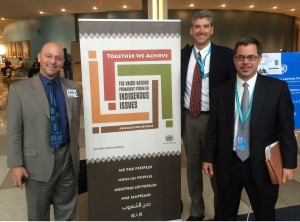Engaging Indigenous Peoples on Environmental Justice at the UN Permanent Forum
![IMG_0061%20-%20PF%20Blog[1]](https://webarchive.library.unt.edu/web/20170118210339im_/https://blog.epa.gov/blog/wp-content/uploads/2017/01/IMG_006120-20PF20Blog1.jpg)
About the Authors – Ethan Shenkman is the Deputy General Counsel at the U.S. Environmental Protection Agency. Jim Grijalva is a Professor and Directs the Tribal Environmental Law Project of the Northern Plains Indian Law Center at the University of North Dakota School of Law. Danny Gogal is the International Human Rights Coordinator and the Environmental Justice Tribal and Indigenous Peoples Program Manager for EPA, and resides in the Office of Environmental Justice.
At the EPA, we see providing meaningful engagement for our most vulnerable and underserved communities as a fundamental part of fulfilling our mission to protect this country’s environmental quality and public health. This work includes engagement with federally recognized tribes and indigenous people.
At the United Nations 15th Permanent Forum on Indigenous Issues, the EPA’s Office of Environmental Justice was able underline the importance of this principle by hosting a panel to highlight the agency’s 2014 Policy on Environmental Justice for Working with Federally Recognized Tribes and Indigenous Peoples. The policy seeks to better clarify and integrate the principles of environmental justice throughout the Agency’s work with federally-recognized tribes and other indigenous peoples.
During the panel, “Environmental Justice and Indigenous Peoples,” the Policy was commended for its efforts to ensure effective engagement and collaboration on environment and public health with federally-recognized tribes on a government-to-government basis as well as opportunities for all members of indigenous communities.

Ethan Shenkman, Jim Grijalva, and Danny Gogal at the UN Permanent Forum on Indigenous Issues
EPA’s Danny Gogal described the historical development of both the agency’s tribal program and its environmental justice program; Ethan Shenkman explained what the EPA is doing to ensure that the rights of Indian tribes and indigenous communities are adequately considered in Agency decision-making, which can help promote effective environmental governance; and, Jim Grajalva from the University of North Dakota’s School of Law reported on the multiple successes as well as remaining challenges of the EPA’s Indian and tribal program and how the role of non-governmental and grassroots organizations can assist tribes and indigenous people in protecting their environments.
The panel provided a unique opportunity for all of us to connect with representatives from federally-recognized tribes and other indigenous peoples, foreign governments, non-governmental organizations, and various federal agencies.
Participants stressed the significance of ensuring the meaningful involvement of not only the leadership of federally recognized tribes, but also state-recognized tribes, indigenous and tribal community-based organizations, and individual members of tribes. This is in keeping with the environmental justice principle that the people most directly impacted by environmental laws and policies must be central to the development and implementation of those laws and policies.
This engagement and consideration is exactly what the EPA is working to strengthen. By promoting sound environmental governance through opportunities for public participation, access to information, implementable and enforceable laws and strong accountability mechanisms, we believe that the EPA continues to make significant progress as the result of the Policy on Environmental Justice for Working with Federally Recognized Tribes and Indigenous Peoples.
For example, the EPA recently held discussions about uranium mine cleanup plans, including voluntary alternative housing options, with the Navajo Nation’s Red Water Pond Road community. Such direct engagement with indigenous communities promotes better governance by providing full access to information and meaningful public participation.
![Permanent%20Forum%20-%20Blog[1]](https://webarchive.library.unt.edu/web/20170118210339im_/https://blog.epa.gov/blog/wp-content/uploads/2017/01/Permanent20Forum20-20Blog1.jpg) And recently, the EPA released EJ 2020 Action Agenda, its five-year environmental justice strategy, which includes specific actions and measures for how the EPA intends to work collaboratively with federally recognized tribes and other indigenous peoples.
And recently, the EPA released EJ 2020 Action Agenda, its five-year environmental justice strategy, which includes specific actions and measures for how the EPA intends to work collaboratively with federally recognized tribes and other indigenous peoples.
The UN Permanent Forum serves as a valuable venue for UN Member States and indigenous peoples throughout the world to share best practices, policies, programs and activities. Through these dialogues, we are able to improve the environment and public health conditions while protecting indigenous culture and quality of life.
We look forward to continuing this conversation and to sharing more at the 2017 Permanent Forum on progress made to provide for environmental justice for tribes and indigenous peoples in the United States, so other countries can learn from our successes as well as our shortcomings.
